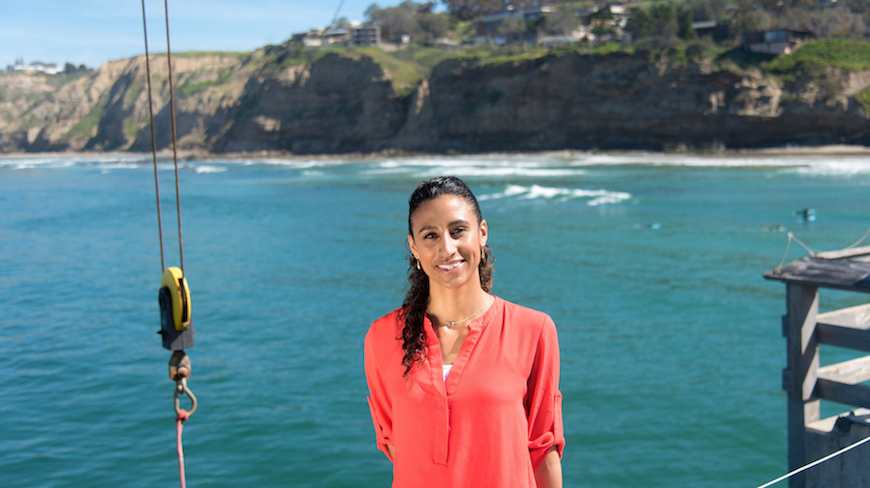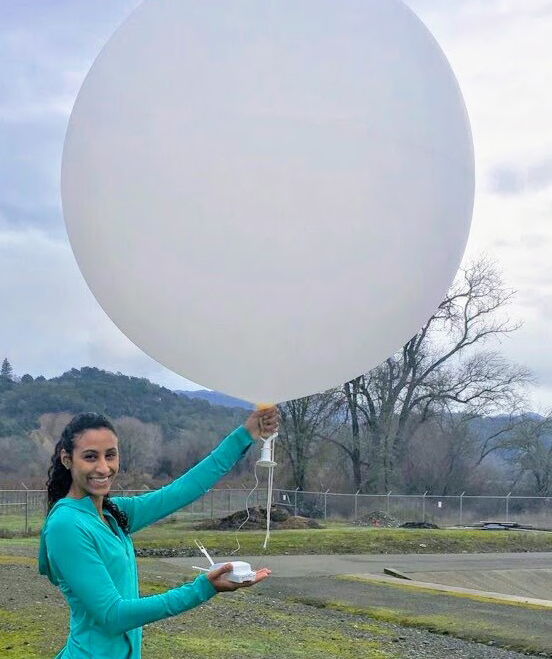| 正文(英文) |
 Scripps graduate student Tashiana Osborne.
Tashiana Osborne is a fourth-year graduate student at Scripps Institution of Oceanography at the University of California San Diego. She spent her childhood growing up both in Saint Paul, Minnesota and Phoenix, Arizona. She received her undergraduate degree from Saint Cloud State University in Minnesota, where she double majored in meteorology and hydrology and minored in mass communication.
Osborne now studies climate sciences with a specialization in hydrometeorology, which combines meteorology and hydrology, in the labs of Scripps scientists Art Miller and Marty Ralph. She also has the opportunity to conduct field work with the Center for Western Weather and Water Extremes a few months every year to study atmospheric rivers, a big topic of her research. We talked to Osborne to see what made Scripps stand out to her, how she became interested in climate sciences, and more.
Why did you choose to attend Scripps to pursue a PhD?
Tashiana Osborne: Honestly, Scripps was my dream school! When I received the acceptance email, I actually jumped up and down, cried, and called my grandmother to share the news. Scripps absolutely has established a strong reputation when it comes to training leaders in oceanography and climate sciences, it offers many unique opportunities for students, and is located in the most idealistic-seeming setting (imagine a beach sunset). More importantly for me, however, was that at the Scripps Open House, I had found two advisors, Art Miller and Marty Ralph, who I could tell genuinely believed in me, and shared research interests. This was key!
What are you researching at Scripps?
TO: I study extreme rain and snow events that affect the western U.S., their impacts, and the ocean-atmosphere patterns and phenomena that may be driving them. In the western U.S., many of the extreme weather and water events we experience are tied to atmospheric rivers hitting the West Coast during October through April. Atmospheric rivers (ARs) are like rivers in the sky; they are long, narrow bands of enhanced water vapor in the lower atmosphere, often associated with an extratropical cyclone. West Coast ARs form over equatorial regions of the Pacific Ocean and carry moist air from the tropics as they move. They can travel toward land, sometimes hitting parts of California, Oregon, Washington, and/or the Baja Peninsula, with widespread impacts also further inland.
I focus on the effects of ARs once they reach land, including how their moisture interacts with mountains, whether we see rain or snow resulting in certain areas, and how streamflow and runoff are affected. ARs can provide large amounts of water for residential and agricultural use, but can also contribute to destructive flood or snow events. On the other hand, a prolonged absence of ARs can lead to severe droughts. I'm also interested in ARs and extremes in South Africa, and in complementary efforts that help address the United Nations' Sustainable Development Goals.
How did you become interested in this field?
TO: Having grown up in both Minnesota and Arizona, I experienced everything from tornado weather, hail, snow and ice, and hot, humid summers, to dry desert heat and monsoon rains. I loved Minnesota’s many lakes and rivers, and saw beauty in Arizona’s desert sunsets. Even though we faced struggles at times, my brother and I were fortunate to be exposed to nature thanks to some of our quirky nature-loving family members. I was intrigued by the mystery and beauty of it all. Nature provides an escape; a way to connect with something bigger than myself through some of the most challenging periods of my life. When I was ten, I had a school assignment to write about what I wanted to be “when I grew up.” I thought of how I loved lying in the grass to look up at the sky and picture which animals and shapes the clouds looked like. This is when I decided I’d be a meteorologist; more specifically, a TV meteorologist for KARE-11 News in Minneapolis. At the time, I didn’t fully recognize that meteorologists were scientists, but they were the types of scientists I was exposed to through TV. (And, I found out later on that meteorologists do much more than gaze at clouds!) I’m also driven in knowing how important diversity and representation are for finding and implementing solutions that help all communities.
What’s life like as a Scripps student?
TO: During most days, I’m writing computer scripts to extract, analyze, and visually represent information from various types of datasets (from radars, satellites, weather models, and more), considering methods and ways to break down research efforts, piecing together materials to show colleagues and advisors, writing outlines, and reading pre-existing research publications. I love that my officemate, Liz Drenkard, and I have become such close friends. We sometimes take breaks near the beach, sip hot cocoa near the Scripps Pier, or go snorkeling. Liz has really helped me understand the value of taking short breaks for moving thoughts forward.
Does your research ever take you out in the field? Describe what field work is like for you.
TO: From December through March, I sometimes have opportunities to do field work in Northern California. I sign up for a few weeks where I’m essentially “on-call.” This means, if the Center for Western Weather and Water Extremes forecasts there will be an atmospheric river, I might suddenly be contacted to pack up and book a flight to Ukiah, Calif. During field work, we launch weather balloons with radiosondes every three hours so we can measure atmospheric pressure, winds, temperature and humidity at different levels of the atmosphere. Yes, this means some of us take the overnight shifts, and we sometimes experience wind, rain, and cold, but we do our best to prepare with proper gear, and take turns so no one ends up too sleep deprived. These experiences rev-up my excitement for science, and make me feel part of a mission.
What’s the most exciting thing about your work?
TO: There’s a side of my work that makes me feel like an explorer, with a sense of purpose in knowing it might possibly contribute to something greater. Moments when I’m able to overcome an intimidating challenge, and moments when I get to share science and my personal journey with others are also very rewarding and drive me forward.
Are there any role models or mentors who have helped you along the way?
TO: I’m grateful to have grown up learning from my grandmother’s hard work ethic and leadership, my mom’s will to go back to finish college as a single mother of two young children, my brother’s creativity and way of questioning things around him, and my aunt and uncle’s focus on balancing work and family life. I had strong support while at St. Cloud State, especially from the Multicultural Student Services where I worked (Shahzad Ahmad, Julie Cruz, Angie Witte, Shawn Kakuk, and more), Caroline Williams, and the Department of Atmospheric & Hydrologic Sciences (Tony Hansen, Brian Billings, Kate Pound, Jean Hoff, Alan Srock, Juan Fedele, etc.). As a PhD student, I’ve found support through postdocs, fellow students, professors, my advisors, committee members, and mentors from other organizations. Myrl Hendershott, Amin Dezfuli, Anna Wilson, Brian Henn, Joel Norris, and close friends have especially helped me grow through certain challenges graduate school can present.
What are some of the challenges you face as a student?
TO: It’s important to acknowledge that higher education programs, especially in STEM, can present students from underrepresented groups with additional challenges. We’ve seen that diverse perspectives contribute to better science, and that diversity initiatives without inclusion might not be enough. In 2016, the Scripps community headed an effort leading to Scripps hiring its first-ever diversity initiatives coordinator, Keiara Auzenne. I would really like to see improvements in these areas. Since graduate school, I’ve become an advocate of seeking and protecting a healthy mind in addition to prioritizing other aspects of health and well-being. I see how precious and important health is, and how it affects every other area of life. I’ve also moved toward being gentler in my thinking: I’ve never done a PhD before, so of course there will be challenges. Things may take more energy, time, and revisions than first expected. Even if it feels like small steps, there is a trend of forward-movement, a support system, a rooted sense of purpose, and scattered a-ha moments which can be very encouraging.
This interview has been condensed and edited. You can find Tashiana on Twitter @TashianaOsborne and the Center for Western Weather and Water Extremes @CW3E_Scripps.
- Shawndiz Hazegh
This story appears in explorations now, Scripps Institution of Oceanography's award-winning ocean and earth science magazine. Sign up to receive our free monthly story roundup.
|







修改评论